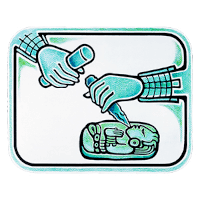JADE
The word jade refers to two different minerals: jadeite and nephrite, both from group VIII (inosilicates), according to the Strunz classification. To be considered jade, both must be present as aggregates in the form of very fine granules or intertwined fibers.
Nephrite Jade, very common in Asia, is often called Chinese Jade, as it is used to make beautiful carved pieces with various motifs such as Buddhas, dragons, and snakes, as well as some oriental symbols. Similarly, large deposits of Nephrite Jade are found in places such as British Columbia, Canada; Alaska and Wyoming, the United States; and Australia and New Zealand, where it is known as “The Green Stone.”
The other type of Jade identified by gemologists is Jadeite Jade, which is a rarer and harder-to-find type of Jade. It can be found in four main locations around the world: Myanmar (formerly Burma); Japan; Russia; and Guatemala.
Jade has been used to make a variety of products and has gained a reputation as a good luck charm. For over 5,000 years in China and Mesoamerica, jade has been used as a material for making utensils and ornaments; it has also been used to make weapons and tools due to its hardness and durability.
| CHARACTERISTICS | HARDNESS* | ORIGIN | SHORTAGE | CULTURAL IMPORTANCE | CHEMICAL COMPOSITION | COLORS |
|---|---|---|---|---|---|---|
| JADE | 7.0 - 7.5 | Guatemala, Japan, Russia And Myanmar | rarest and most scarce | Mesoamerica, from southern Mexico to Costa Rica | Sodium silicate | Whites, greens; from very light to dark, apple green, black, pink, lilac, and light blue. In addition to emerald or imperial green and orange, very special and rare colors; from opaque to translucent. |
| NEFRITA | 6.0 - 6.5 | China, Canada, and New Zealand | More Common | China and New Zealand | Sodium Silicate and Mangese | Different green notes, from yellow to brown, white, gray, black; from pale to translucid |
* in Moh’s scale. Where diamond scores 10.

| JADE | Characteristics | NEFRITA |
|---|---|---|
| 7.0 - 7.5 | HARDNESS* | 6.0 - 6.5 |
| Guatemala, Japan, Russia And Myanmar | ORIGIN | China, Canada, and New Zealand |
| rarest and most scarce | SHORTAGE | More Common |
| Mesoamerica, from southern Mexico to Costa Rica | CULTURAL IMPORTANCE | China and New Zealand |
| Sodium silicate | CHEMICAL COMPOSITION | Sodium Silicate and Mangese |
| Whites, greens; from very light to dark, apple green, black, pink, lilac, and light blue. In addition to emerald or imperial green and orange, very special and rare colors; from opaque to translucent. | COLORS | Different green notes, from yellow to brown, white, gray, black; from pale to translucid |
* in Moh’s scale. Where diamond scores 10.
Symbolism of the different colors of Jadeite Jade
Moon
and pure love.
Light Green
life, has healing effects, resolves irritability, converts negative energy into positive.
Green Apple
converts negative energy into positive
Green Jaguar
converts negative energy into positive
Sky Blue
Lavender
attracts love, good health, relieves emotional pain.
Black
Orange
Imperial Green
were formerly only carried by royalty
and people with a lot of power.
GUATEMALAN JADE
The variety of jade found in Guatemala is jadeite jade.
The main source of jadeite jade, as it was for Mesoamerican cultures, is found in the arid region of Zacapa, in the Sierra de las Minas and the Motagua River, about 120 miles northwest of the Guatemalan capital. This region is very rich in minerals due to the catastrophic Motagua Fault, where the following minerals can be found: quartz in its different varieties, silver, zinc, iron, copper, nickel, marble, alabaster, and the sacred stone of jade.
In the Motagua River Valley in Guatemala, lies one of the richest jade deposits in the world, where a wide variety of jade colors are found.
JADE COLORS IN GUATEMALA
The color range of Guatemalan jadeite jade ranges from a grayish white, which scientists say is basically one of the first colors formed. Chemically, it is the base (sodium aluminum silicate) present when it is expelled to the surface. This process takes thousands of years, and in this process, the jade acquires different elements added to its chemical composition, thus resulting in its color change.
Some minerals that produce various colors of jadeite jade are:
Titanium causes pastel colors, especially lilac and opal shades. These shades were discovered during Hurricane Mitch in 1998.
Iron contributes from a dark green to the rare black jade, chemically known as chloromelanite and found only in Guatemala.
Chromium causes the green shades up to emerald green, known as Imperial Jade. A color characterized by its scarcity, as it is usually a vein within a rock or sometimes more like a core, which is why it is almost extinct today.
All these beautiful shades make our country’s Jade a source of national pride.
JADE IN MESOAMERICAN CULTURES
Jade was considered extremely valuable to our ancestors. For the pre-Hispanic cultures of Mesoamerica, such as the Olmecs, Mayans, Toltecs, Kichés, Mixtecs, Zapotecs, and Aztecs, jade was the stone of creation; it signified life, fertility, and power. It symbolized the jungle, the green of plants, the green of forest life, and this is the reason for the concept of a passport to another world, the world the Mayans called “XIBALBA” (The Underworld). Archaeologists have determined that jade was definitely the property of the noble class. Therefore, jade was even valued more than gold.
Our ancestors achieved impressive development in the creation of jade artworks, true treasures found in tombs at various archaeological sites from the Valley of Mexico to Costa Rica. These treasures include necklaces, bracelets, rings, anklets, figurines, skulls with dental inlays, and even impressive mosaic works like the funerary mask of King Pacal; and masterpieces from Tikal, such as the portrait vases of Yikin Chan Kawil and Hasaw Chan Kawil, or the beautiful funerary mask from Tomb 160, which possibly belonged to the ruler Kalomte Balam.
Considering the hardness of jade and the fact that jade is currently worked with industrial diamond machinery, the question arises: How did the ancient Mayan culture work this sacred stone more than 2,000 years ago without the use of sophisticated technology?
Based on a discovery at the archaeological site of Cancuén, some possible techniques used by the Mayans to work jade have been determined. One of these techniques was rubbing jade on jade and using saw-like tools made of leather with an abrasive, such as quartz, to cut part of the large stone. Evidence has also been found of tools made of the same jade with hard, resistant wooden handles to create the details of the sculptures. They also used drill bits made of the same jade to drill the beads of their ceremonial necklaces (called “Chachales”) or earrings. Finally, it is believed that they gave the pieces a certain shine with tree resins, crystal powders, and sand, as if it were modern sandpaper. Even today, it is an incredible mystery to understand how, with such limited technology, our ancestors produced such amazing pieces.
.




JADE-LIKE STONES
Almost from the beginning, attempts have been made to sell other minerals under the name jade, which was achieved with the mineral called serpentine. Serpentine not only looks like jade, but also occurs in the same deposits as jadeite and nephrite. It is a softer and less durable material than jade. Because it works much better than jade, it has established itself as a preferred substitute in recent years.
In Guatemala, we can find many other stones that are not jade, including guatemalite, quartz, obsidian, and serpentine.

